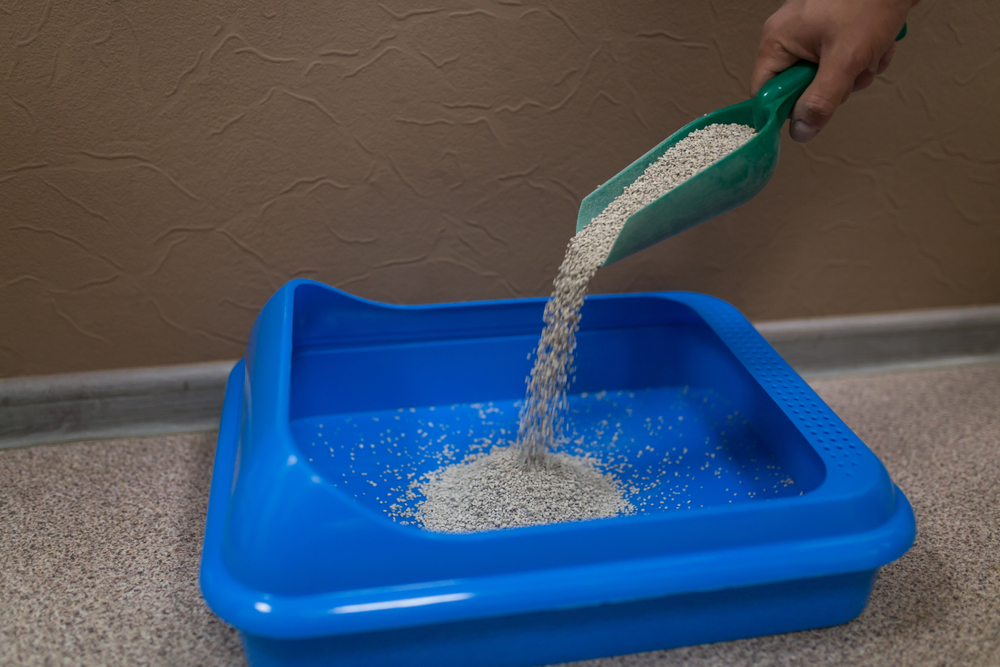Cat owners often assume that litter box training is easy—they simply show their new cat the litter box, and their cat will consistently eliminate at that location. If it were truly this easy, inappropriate elimination would not account for so many veterinary visits, and be responsible for hordes of cats losing their homes each year. The fact is, cats are extremely particular about their bathroom accommodations, and a number of factors can lead to litter box aversion. Being aware of specific feline preferences can help your cat love their litter box, however, and keep their waste where it belongs. Here, our Boca Midtowne Animal Hospital team shares their top 10 tips for litter box success.
#1: Choose a cat-friendly litter
Many cat litter varieties, such as scented brands and those with odor-absorbing additives, are made with cat owners in mind, rather than cats. In general, cats prefer unscented litter without additives or chemicals. Sand is actually the most appealing substrate to housecats, since they descended from the African wild cat, who used the desert as a natural litter box. Feline behaviorists often recommend a sand-based litter as part of a multimodal plan to treat inappropriate elimination.
#2: Don’t abruptly change your cat’s litter type
That being said, don’t suddenly change your cat’s litter. Although you may switch to a more appealing type, cats dislike change, and may be turned off. If you want to try a new litter type, add an additional litter box, following all the tips, and fill it with the new brand. If your cat uses the new litter, gradually switch their other litter boxes.
#3: Don’t skimp on your cat’s litter
Cats like to dig a hole, eliminate, and cover it, which requires a thick layer of litter. You should fill your cat’s litter box to about four inches deep, and maintain this depth by adding more after scooping it daily.
#4: Keep your cat’s litter box open
Although a covered litter box may appeal to you more, cats often dislike hoods and may avoid covered boxes. Covered litter boxes are also often too small to allow your cat enough room to move around freely. Choose an uncovered litter box that is one and a half times your cat’s length. A low-sided under-the-bed plastic storage container makes an inexpensive litter box, and is generally well-accepted by cats.
#5: Provide an adequate number of litter boxes for your cats
In multi-cat households, one cat may prevent others from using their favorite litter box, or multiple cats may simply need to eliminate at the same time. If you have shared a bathroom with multiple people, you know that accommodating everyone can be challenging, and your cats may get similarly frustrated. Provide one litter box for each household cat, plus an additional box, to prevent bottlenecks.
#6: Choose a cat-friendly location
Place your cat’s litter box in a quiet, out-of-the way location to afford them privacy. Although you may think your laundry room is the perfect spot, your cat will not appreciate loud noises from nearby appliances. Your dryer or furnace suddenly kicking on may scare your cat mid-stream, and cause an aversion to their litter box.
#7: Keep your cat’s litter box clean
No one, including your cat, wants to use a dirty, smelly bathroom. Scoop your cat’s litter at least once a day to remove feces and urine clumps. Every two weeks, completely dump the old litter, clean the box, and fill it with fresh litter. Non-clumping litter will need to be changed out more frequently.
#8: Don’t use harsh chemicals to clean your cat’s litter box
Your cat’s plastic litter box will absorb cleaning chemicals and retain their scent, which can turn your cat away. You may love the smell of bleach or pine-scented cleaner, but your cat will likely think differently, and strong scents may irritate their respiratory tract. Ideally, use only warm water when cleaning your cat’s litter box. If you must use soap, stick to mild dish soap, and rinse the box thoroughly.
#9: Replace your cat’s litter box regularly

Over time, your cat’s plastic litter box will absorb urine and fecal odors, despite regular washing. Your cat has a sensitive nose, and can detect these odors long before you do. Replace your cat’s litter boxes every 6 to 12 months to keep them smelling clean.
#10: Do not choose an automated litter box for your cat
Automated litter boxes may seem the perfect solution to your litter woes—after all, they clear the box after each elimination so your cat’s box is always clean. Your expensive litter box may startle your cat by kicking on while they are still inside, and your cat may hesitate to use the box again. You are safer sticking to a regular litter box, and remembering to scoop often.
If your cat is having litter box issues, contact us for help. Our Boca Midtowne Animal Hospital team can determine whether a medical condition is to blame, and help you resolve the problem.








Leave A Comment